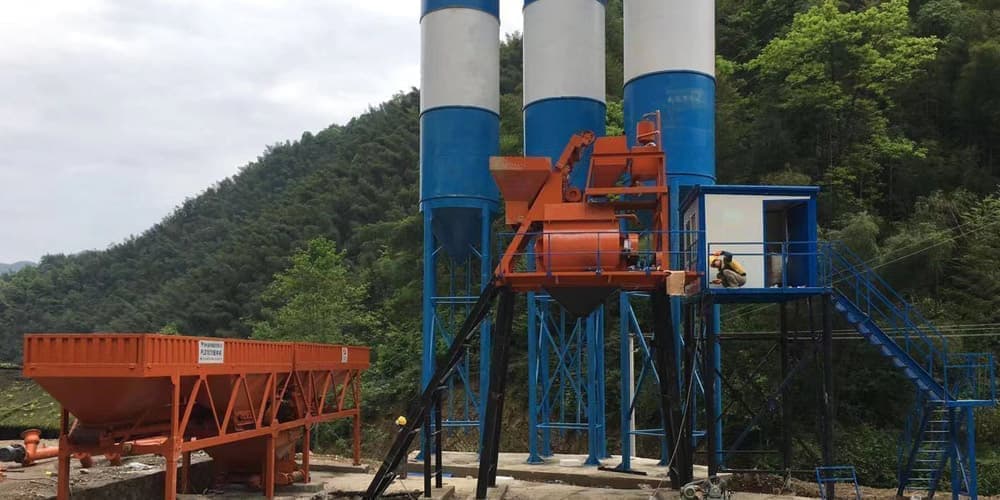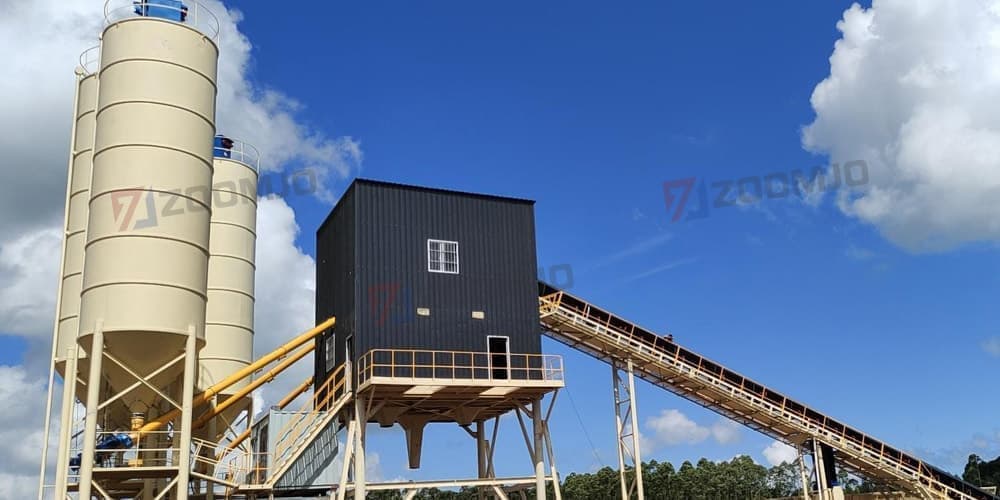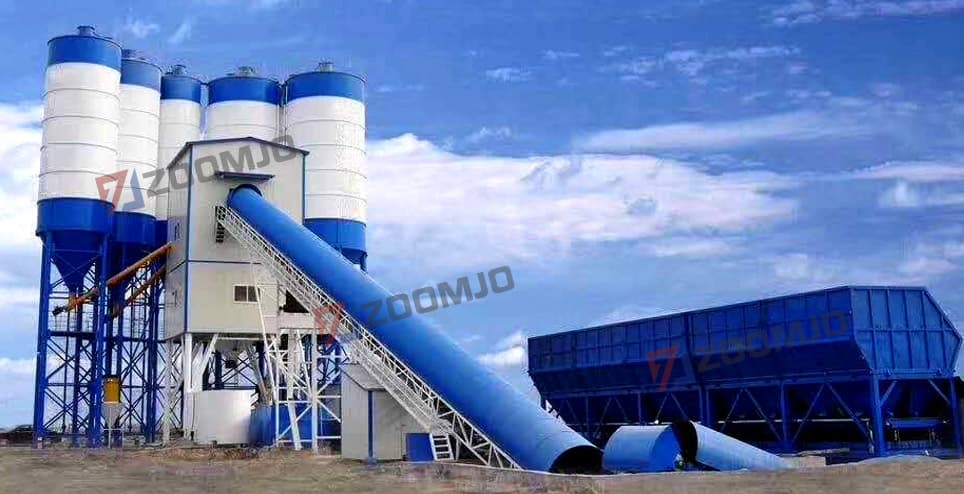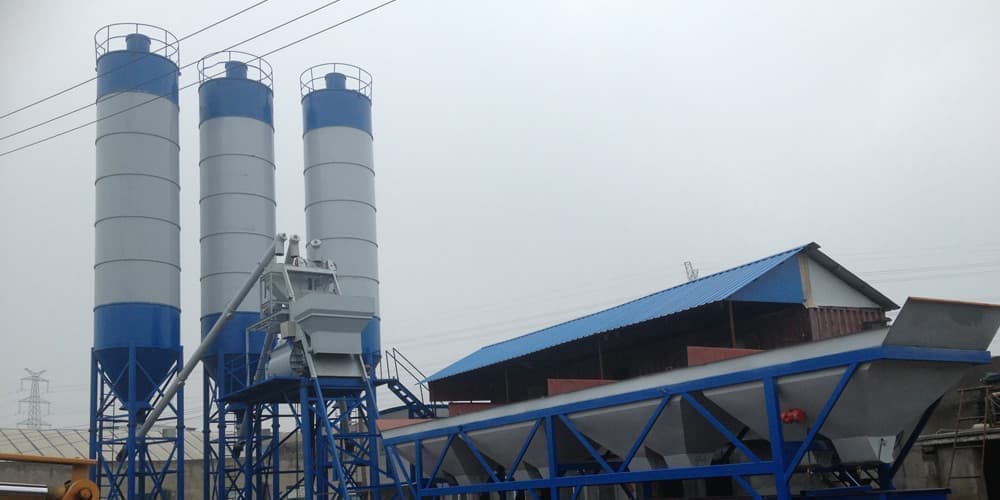A Beginner's Guide to Concrete Batching Plant Types

A concrete batching plant, also known as a concrete mixing plant, is a piece of equipment designed to produce concrete, which is widely used in various types of construction and infrastructure projects. A complete concrete batching plant usually includes a mixing system, an aggregate supply system, a powder storage system, a liquid storage and metering system, a powder metering system, a control system, and external auxiliary equipment. These equipments are the core of concrete production, and their performance and configuration directly affect the quality and efficiency of the project.
Classification of Concrete Batching Plant
There are various types of concrete mixing plants, which can be categorised according to different criteria such as capacity, cost, use, structure, layout, number of mixers, etc. Common types include mobile, stationary and small concrete batching plants. Understanding these types and their features can help in choosing the right mixing plant for a particular project.
Categorised according to the mode of mobility
Mobile Concrete Batching Plant
The most notable feature of this type of mixing plant is its flexibility. It can be easily moved around depending on the needs of the project, making it ideal for projects that require frequent changes in construction locations without the need for a fixed installation on the job site. Usually towed by a trailer, the mobile mixing plant has a simple structure, compact size and good manoeuvrability, enabling it to be quickly deployed to the project site, especially for construction projects requiring frequent transfers, such as motorways, railways and bridges.
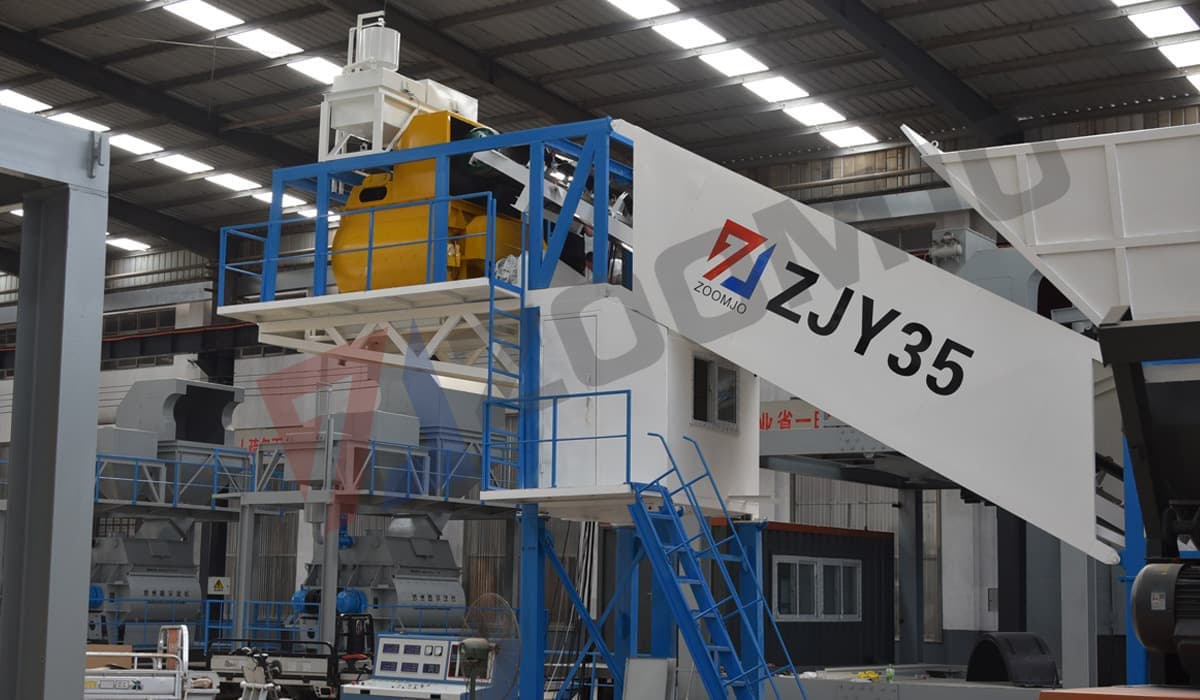
The mobile mixing plant generally consists of mixing machine, aggregate batching system, water and powder batching system, control system and other parts. Its mixing host usually adopts forced double horizontal shaft mixer to ensure the mixing quality of concrete.
The advantage of mobile mixing plant is its powerful mobility and short installation and dismantling time, which makes it suitable for short-term and frequently shifting projects. Although its capacity may not be as high as a stationary mixing plant, it can still perform well in small and medium-sized projects.
Model parameters of mobile concrete batching plant
| Model | ZJY25 | ZJY35 | ZJY50 | ZJY60 | ZJY75 | ZJY90 | ZJY120 |
| Mixer | JS 500 | JS 750 | JS 1000 | JS 1000 | JS 1500 | JS 1500 | JS 2000 |
| Mixer Capacity | 0.5m³ | 0.75m³ | 1m³ | 1m³ | 1.5m³ | 1.5m³ | 2m³ |
| Output | 25m³/h | 35m³/h | 50m³/h | 60m³/h | 75m³/h | 90m³/h | 120m³/h |
| Aggregate bins Capacity | 2*6m³ | 2*8m³ | 2*8m³ | 2*10m³ | 2*10m³ | 2*12m³ | 2*12m³ |
| Discharging Height | 3.8m | 3.8m | 3.8m | 3.8m | 3.8m | 3.8m | 3.8m |
| Aggregate Weighing Accuracy | ±2% | ±2% | ±2% | ±2% | ±2% | ±2% | ±2% |
| Cement Weighing Accuracy | ±1% | ±1% | ±1% | ±1% | ±1% | ±1% | ±1% |
| Water Weighing Accuracy | ±1% | ±1% | ±1% | ±1% | ±1% | ±1% | ±1% |
| Additive Weighing Accuracy | ±1% | ±1% | ±1% | ±1% | ±1% | ±1% | ±1% |
| Max.Aggregate Size | 80/100mm | 80/100mm | 80/100mm | 80/100mm | 80/100mm | 80/100mm | 80/100mm |
| Max hauling speed | 8km/h | 8km/h | 8km/h | 8km/h | 8km/h | 8km/h | 8km/h |
| Power | ≈60.8kw | ≈72.3kw | ≈92kw | ≈92kw | ≈102kw | ≈120kw | ≈160kw |
| Total weight | 14.66t | 22t | 26t | 26t | 29t | 33t | 38t |
Stationary Concrete Batching Plant
Typically fixed and installed in a specific location with large storage facilities and conveying systems, stationary concrete batching plants are known for their high productivity and durability, making them ideal for large construction sites and large-scale concrete production. Favoured for their strong production capacity, stable plant performance and high quality concrete, these plants are particularly suitable for long-term, large-scale projects such as high-rise buildings, hydroelectric power stations and large-scale infrastructure construction. However, due to its higher initial investment and larger footprint, stationary batching plants have limitations in terms of project transfer and flexibility.
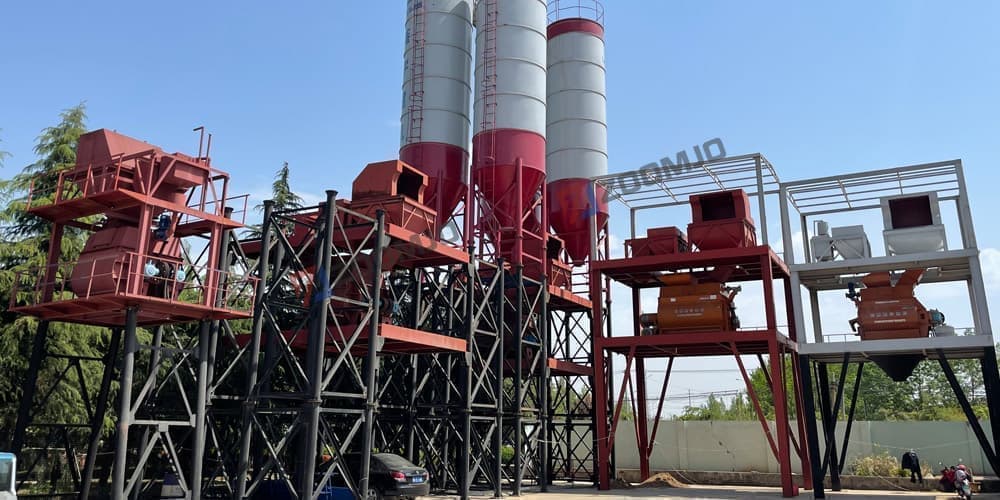
Model Parameters of Stationary Concrete Batching Plant
| Model | HZS / ZJ25 | HZS / ZJ35 | HZS / ZJ50 | HZS / ZJ60 | HZS / ZJ75 | HZS / ZJ90 | HZS / ZJ120 | HZS / ZJ180 | HZS / ZJ240 |
| Productivity | 25m³/h | 35m³/h | 50m³/h | 60m³/h | 75m³/h | 90m³/h | 120m³/h | 180m³/h | 240m³/h |
| Concrete mixer | JS 500 | JS750 | JS1000 | JS1000 | JS1500 | JS1500 | JS2000 | JS3000 | JS4000 |
| Mixer discharging capacity | 0.5m³ | 0.75m³ | 1m³ | 1m³ | 1.5m³ | 1.5m³ | 2m³ | 3m³ | 4m³ |
| Feeding Mode | Lift Hopper | Lift Hopper | Lift Hopper | Belt Conveyor | Lift Hopper | Belt Conveyor | Belt Conveyor | Belt Conveyor | Belt Conveyor |
| Aggregate batching machine | PLD800 | PLD1000 | PLD1600 | PLD1600 | PLD2400 | PLD2400 | PLD3200 | PLD4800 | PLD6400 |
| Kinds of aggregate | 2/3/4 | 2/3/4 | 3/4 | 3/4/5 | 3/4 | 3/4/5 | 3/4/5 | 3/4/5 | 3/4/5 |
| Max aggregate size | 80/100mm | 80/100mm | 80/100mm | 80/100mm | 80/100mm | 80/100mm | 80/100mm | 80/100mm | 80/100mm |
| Discharging height | 3.8m | 4.1m | 4.1m | 4.1m | 4.1m | 4.1m | 4.3m | 4.3m | 4.3m |
| Aggregate weighing accuracy | ±2% | ±2% | ±2% | ±2% | ±2% | ±2% | ±2% | ±2% | ±2% |
| Cement weighting accuracy | ±1% | ±1% | ±1% | ±1% | ±1% | ±1% | ±1% | ±1% | ±1% |
| Water weighing accuracy | ±1% | ±1% | ±1% | ±1% | ±1% | ±1% | ±1% | ±1% | ±1% |
| Additive weighing accuracy | ±1% | ±1% | ±1% | ±1% | ±1% | ±1% | ±1% | ±1% | ±1% |
| weight | 10t | 13.5t | 18.5t | 28t | 25t | 40t | 65t | 88t | 98t |
| General installed power | ≈65kw | ≈75kw | ≈100kw | ≈110kw | ≈140kw | ≈160kw | ≈220kw | ≈290kw | ≈340kw |
Mobile VS Stationary Concrete Batching Plant
| Item | Mobile Concrete Mixing Plant | Stationary Concrete Mixing Plant |
|---|---|---|
| Mobility | High | Low |
| Production Capacity | Relatively Small | Large |
| Investment Cost | Low | High |
| Land Occupation | Small | Large |
| Scope of Application | Medium and small projects, limited space, short construction period | Large projects, spacious site, long construction period |
Classification according to capacity
According to the different capacity, concrete mixing plant can be classified into small, medium and large.
Small Concrete Batching Plant
Small concrete mixing plant is suitable for smaller scale projects, such as rural self-built houses, small commercial buildings, maintenance works and so on. This kind of mixing plant has simple structure, small footprint, easy to transport and install, and low cost.
-
Production capacity: Usually produce 25-50 cubic metres of concrete per hour.
-
Configuration: Single horizontal shaft forced mixer, small aggregate silo (usually 2-3), metering system, control panel, etc.
-
Advantage: low investment, simple operation, flexible and mobile, suitable for short-term, small-scale projects.
-
Disadvantages: limited production capacity, relatively difficult to control the quality of concrete, low degree of automation.
Medium Concrete Batching Plant
Medium-sized concrete mixing plant is suitable for multi-storey residential buildings, commercial buildings, small and medium-sized infrastructure projects. This type of plant has moderate production capacity, flexible configuration, can be customised according to the project requirements, and has a high degree of automation.
-
Capacity: Usually 50-120 cubic metres of concrete per hour.
-
Configuration: double horizontal shaft forced mixer, multiple aggregate bins (usually 4-6), metering system, PLC control system, central control room, etc.
-
Advantage: high production efficiency, stable concrete quality, flexible configuration, strong adaptability.
-
Disadvantages: Lower degree of automation and relatively large floor space compared with large mixing plant.
Large Concrete Batching Plant
Large concrete mixing plant is suitable for large commercial plazas, high-rise buildings, hydroelectric power stations, large-scale infrastructure and so on. These plants have strong production capacity, high automation, and can continuously produce large quantities of concrete with stable and reliable quality.
-
Production capacity: usually produce more than 120 cubic metres of concrete per hour.
-
Configuration: several large aggregate silos, cement silos, automated batching system, PLC control system, central control room, online monitoring system and so on.
-
Advantage: very high production efficiency, can meet the concrete demand of large-scale projects, stable and reliable quality of concrete.
-
Disadvantages: High investment cost, large floor space, high requirements for the site.
Classification according to concrete mixing method
According to different methods of concrete mixing, concrete mixing plant can be divided into gravity type and forced type.
Gravity Concrete Batching Plant
Gravity type concrete mixing plant utilises the self-weight of materials to achieve mixing by dumping and falling. The mixing cylinder is tilted, and the materials are tumbled and rubbed in the cylinder, so as to achieve the purpose of mixing.
-
Advantages: simple structure, low cost, easy to operate and maintain.
-
Disadvantages: low mixing efficiency, high requirements on the fluidity of the material, not applicable to the viscosity of the concrete.
-
Scope of application: Small-scale projects, such as rural self-built houses, small commercial buildings.
Forced concrete mixing plant
Forced concrete mixing plant forces the mixture through rotating mixing blades. The mixing drum is equipped with mixing blades, and under the action of high-speed rotation, the materials are subjected to strong shearing and extrusion, so as to achieve uniform mixing.
-
Advantages: high mixing efficiency, uniform concrete quality, wide range of application, can produce a variety of fluidity and compactness of concrete.
-
Disadvantages: Higher manufacturing cost and relatively complex structure.
-
Scope of application: large infrastructure construction projects, such as high-rise buildings, bridges and tunnels.
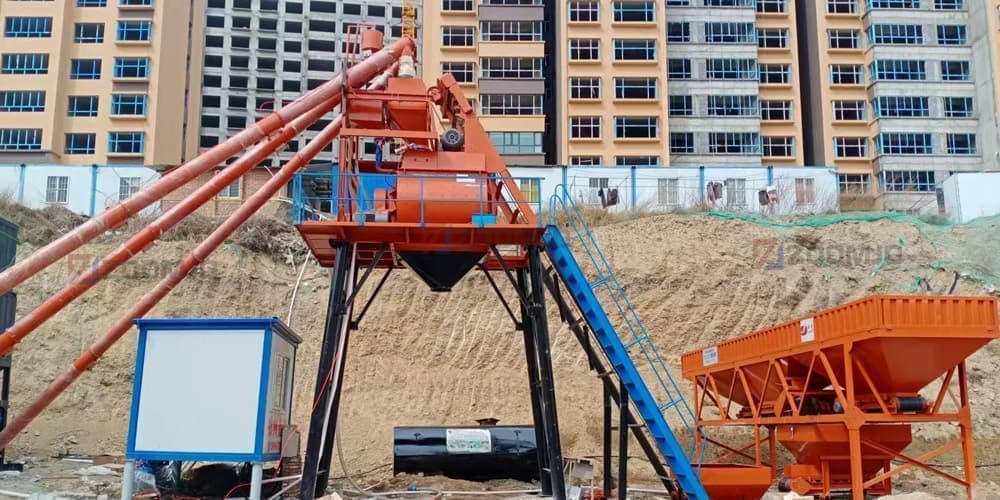
Forced concrete mixing plant is usually equipped with forced concrete mixer, which is mainly divided into the following types according to the number and position of mixing shafts:
-
Double horizontal shaft forced concrete mixer: the most widely used at present, with the advantages of compact structure, high mixing efficiency and strong adaptability.
-
Single horizontal shaft forced concrete mixer: simpler structure, lower cost, suitable for small and medium-sized projects.
-
Planetary forced concrete mixer: the mixing blade moves along the planetary track, the mixing effect is more uniform, but the structure is complicated and the cost is higher.
Classification by Application
Commercial Concrete Batching Plants
Designed specifically to meet the concrete needs of large-scale construction projects, they provide a wide range of concrete products in various sizes and grades. Usually equipped with advanced production lines and automated control systems, they are located in convenient areas to efficiently supply concrete to various construction sites.
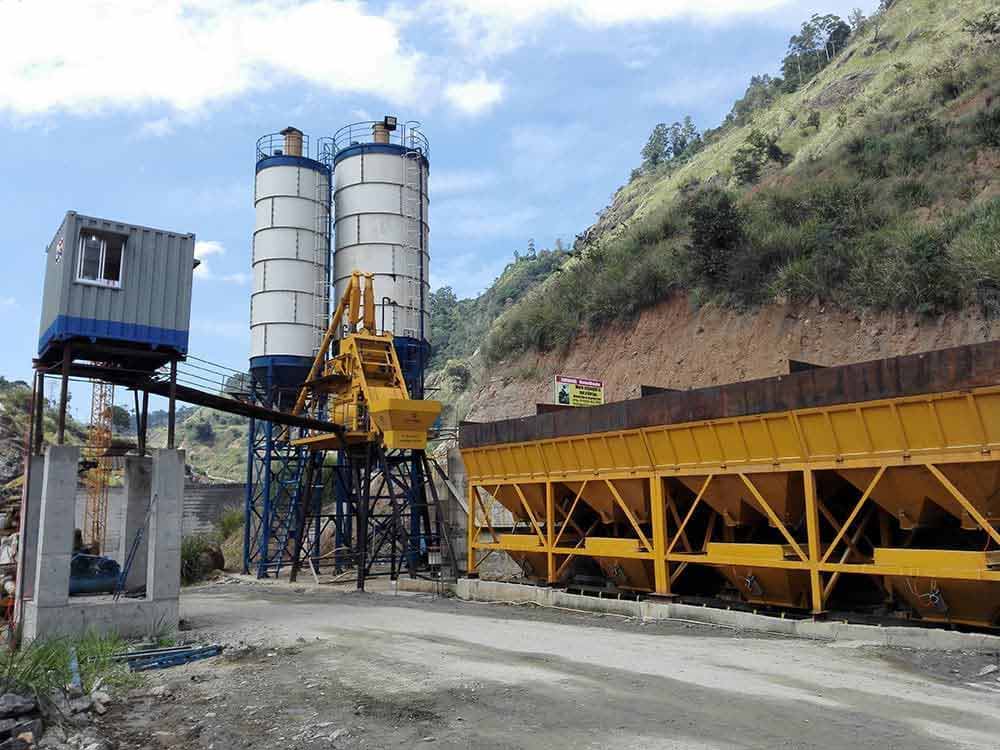
Engineered Concrete Batching Plant
Tailor-made for specific projects with flexible configurations to provide customised concrete according to the specific requirements of the project. They are usually located close to the construction site to facilitate the timely supply of concrete and ensure continuity of construction.
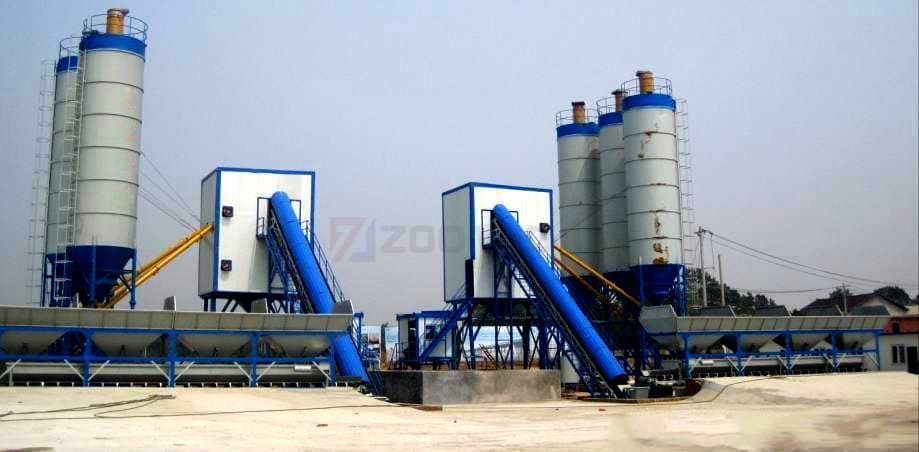
Advice on choosing a concrete batching plant
When selecting a concrete batching plant, several factors need to be considered to ensure that the equipment selected will meet the project's needs while ensuring productivity and concrete quality. Here are some key considerations:
-
1. Project size and demand: The capacity of the batching plant is determined by the size of the project and the demand for concrete. For example, for projects with an annual output of less than 200,000 cubic metres, the production rate of the mixing plant is normally not less than 90 cubic metres per hour; for projects with an annual output of between 200,000 and 300,000 cubic metres, the production rate is normally 120 cubic metres per hour; and for projects with an annual output of more than 300,000 cubic metres, the production rate is normally 150 cubic metres per hour or 200 cubic metres per hour.
-
2. Construction site conditions: Consider the size and topography of the construction site to select the appropriate type of mixing plant. For example, concrete mixing building is suitable for sites with limited space, while mixing plant is suitable for sites with larger space.
-
3. Configuration and quality of equipment: choose equipment with reliable quality and stable performance. The configuration of the mixing plant may be different for different manufacturers and models, and the price also varies. You should choose the right configuration according to your needs to avoid unnecessary waste.
-
4. Mobility: choose fixed or mobile mixing plant according to whether the project requires frequent movement. Mobile mixing plant is suitable for projects that require construction in different locations, while fixed mixing plant is suitable for long-term, stable production needs.
-
5. Technical performance: Consider the advancement, reliability, excellence and versatility of the equipment. The equipment should have a high degree of automation, accurate measurement system, good mixing quality and high production efficiency.
-
6. Supplier's reputation and after-sales service: choose suppliers with good reputation to ensure strict installation and commissioning, technical guidance in place, timely after-sales service, and sufficient supply of spare parts.
-
7. Performance-price ratio: pursue a reasonable performance-price ratio, avoid over-investment or reducing the performance of the equipment to save costs. Reasonable investment can ensure the long-term operational efficiency and cost-effectiveness of the equipment.
-
8. Environmental protection and safety: Consider the environmental performance of the mixing plant, such as dust prevention, noise reduction and waste water treatment. At the same time, ensure that the design of the mixing plant complies with safety standards to safeguard the safety of the operators.
-
9. Site planning and layout: Consider the site planning and layout of the mixing plant to optimise material flow paths, reduce transport time and costs, and minimise environmental impact.
Comprehensive consideration of the above factors can help you choose the concrete batching plant that best suits your project needs.
ZOOMJO provides you with one-stop concrete batching plant solutions, covering the whole process from equipment selection to installation and commissioning to ensure that your specific needs are met. We are committed to providing customers with efficient and reliable equipment and professional technical support to make your concrete production process smoother.
If you want to get more questions and quotations about concrete mixing plant, please feel free to contact us. Our team will be happy to help and advise you to make sure you choose the most suitable equipment.

 English
English  Español
Español  简体中文
简体中文  Pусский
Pусский  українська
українська 